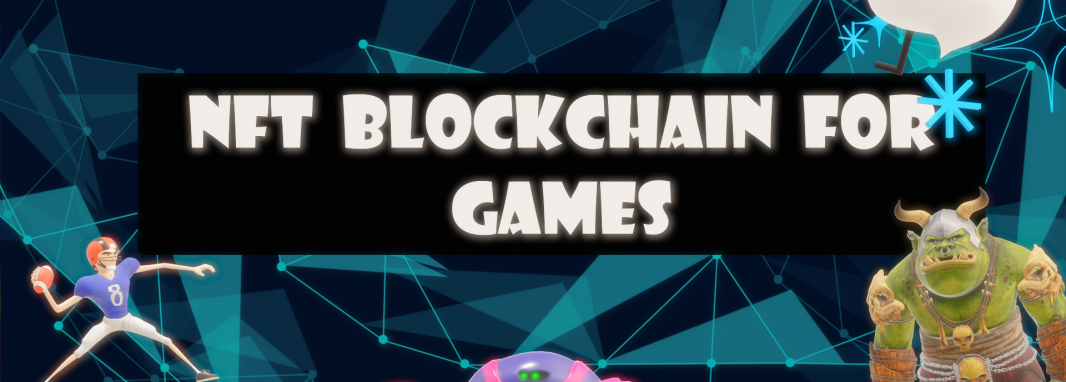Choosing the right blockchain for your NFT game isn’t easy, but it’s an important decision that you’ll want to spend a decent amount of time on to make sure that you get it just right. That’s because once you’ve chosen your blockchain and started building, it isn’t easy to change your mind.
We will help you with your NFT project!
But first off, let’s take a step back and look at a few definitions.
Blockchains are basically incorruptible ledgers that can be used to store all sorts of decentralized data, which means that no single organization has the power to corrupt or lose them. They’re used for everything from keeping cryptocurrency records to healthcare and property information.
NFTs are non-fungible tokens, and they’re mostly known at the moment for being the mechanism by which the provenance of digital art is stored. However, they have a range of other practical applications, most notably in the gaming world, which we’re going to look at today.
The Factors to Consider
When you’re building a game that’s integrated with the blockchain, one of the biggest challenges is choosing a suitable blockchain in the first place. There are several different factors that you’ll want to consider here, including:
Transaction Speed: Different blockchains process transactions at different speeds. As a general rule, the faster the transaction speed, the better the blockchain will be, but that’s not always the case.
Transaction Cost: Blockchains that run at lower speeds tend to have higher transaction costs. The transaction cost will impact your profit margins and determine the financial model that your NFT game uses.
Smart Contract Functionality: Smart contracts can be used to automate many aspects of the blockchain, which means that the greater the functionality on offer, the less you’re going to have to do manually.
Consensus Mechanism: Different blockchains use different consensus mechanisms to ensure that there aren’t any disparities in the data. As a general rule, the best option is to go with a blockchain that uses the proof-of-stake consensus.
Choosing the Right Blockchain
Now it’s time for us to have a look at the options. Here are the different blockchains that you’ll want to consider for your game integration:
Ethereum: Ethereum makes a pretty good default choice, if only because it’s at the head of the market. It didn’t become the market leader without a good reason. There’s a vast community of developers, which is helpful if you need to bring in some external help, and it’s updated on a regular basis and comes with plenty of technical documentation.
Flow: This blockchain was only launched a couple of years ago, but it’s already making waves in the industry and is often cited as the best alternative to Ethereum.
It’s super scalable, compatible with different integrations, and includes upgradeable smart contracts powered by Cadence, the programming language created by the blockchain’s developers.
Binance Smart Chain: Binance Smart Chain (BSC) is a blockchain that runs alongside the Binance chain, but it really stands out because it has much more advanced smart contracts. It uses a system of 21 validators and allows for a great deal of customization on the developer’s side. It’s also capable of performing 60 transactions per second and charging around $3 to create an NFT, making it much much cheaper than Ethereum.
Cardano: This blockchain was launched by an Ethereum co-founder called Charles Hoskinson with the goal of enabling developers to easily and conveniently create scalable and robust applications. It comes with two different layers. The Cardano Settlement Layer is designed to transfer its native cryptocurrency and to record transactions, and the Cardano Computation Layer is what powers its smart contracts.
Solana: Solana has a reputation as being one of the fastest blockchains, and it’s already responsible for a market capitalization of over $65 billion. It also has a transaction fee that’s so low that it’s barely worth mentioning. You’d have to make 4,000 transactions for it to cost you a dollar. It’s currently processing 65,000 transactions every second, but the developers claim it can increase to 700,000 transactions per second as the network continues to grow.
EOS: This blockchain has been designed to enable people to quickly and easily develop decentralized applications and is perhaps best known for having the largest initial coin offering (ICO) ever, raising around $4 billion. It supports any programming language that compiles into WebAssembly and can carry out 4,000 transactions per second with an average confirmation time of 0.5 seconds.
WAX: WAX stands for Worldwide Asset eXchange, and the USP of this blockchain is that it’s carbon-neutral, making it a solid choice if you’re worried about your impact on the planet. It’s able to carry out around 8,000 transactions per second and has over 500,000 users and a total number of transactions of 14.6 million.
Algorand: This blockchain is super secure and is perfect for launching NFTs because the Algorand team has gone out of its way to provide NFT functionality to its users. They’re also working towards being a carbon-negative blockchain through a partnership with ClimateTrade, and they’re mining-free, which means that they’re immune to 51% attacks. The network is capable of performing 1,000 transactions per second and is working towards reaching 46,000 transactions per second.
Tezos: This blockchain Is designed to facilitate effortless transactions between peers and has the ability to deploy sophisticated smart contracts. Tezos can process 40 transactions per second with a transaction fee of ten cents, though they’ve announced plans to cut that down by as much as 75%.
Tron: Tron used to be an Ethereum-based token but has grown to become its own, fully decentralized blockchain that’s released on an open-source license. It supports everything from the development of applications to smart contracts and tokens. It’s able to process 2,000 transactions per second and charges less than a cent per transaction.
Conclusion
Ultimately, choosing the right blockchain for you comes down to understanding which of the factors that we talked about is the most important to you and then finding a blockchain that can offer you the functionality that you need.
The hope is that with the help of this article, you now have a good idea of what you’re looking for, and you can see what differentiates one blockchain from another. The next step is for you to narrow it down to the single blockchain that you’re going to want to use and then to carry out some further research.
Still, need help integrating your game with NFTs and a blockchain? You’re in luck. Reach out to us at Zfort Group today to find out more about how we can help you. We look forward to working with you!
We will help you with your NFT project!






